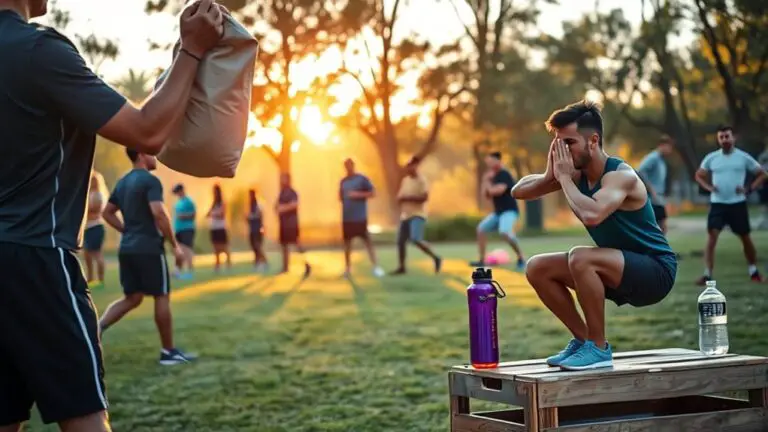The Best Training Methods From Different Cultures Around the World
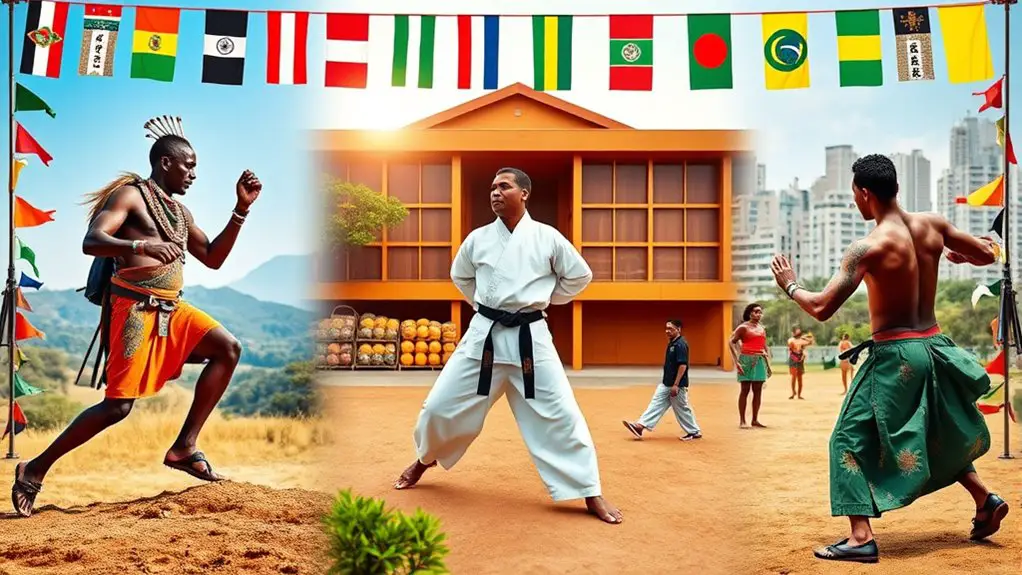
Exploring training methods from various cultures reveals unique techniques that enrich personal growth and community bonds. From the discipline of Japanese martial arts in the dojo to the storytelling traditions of African tribes, each approach emphasizes hands-on experience and holistic learning. The Socratic method encourages critical thinking, while Nordic coaching enhances teamwork. Mindfulness techniques cultivate focus, and the Gurukula system nurtures student-teacher relationships. These diverse philosophies promise transformative experiences, inviting you to discover even more insights into effective training.
The Art of Dojo: Japanese Martial Arts Training
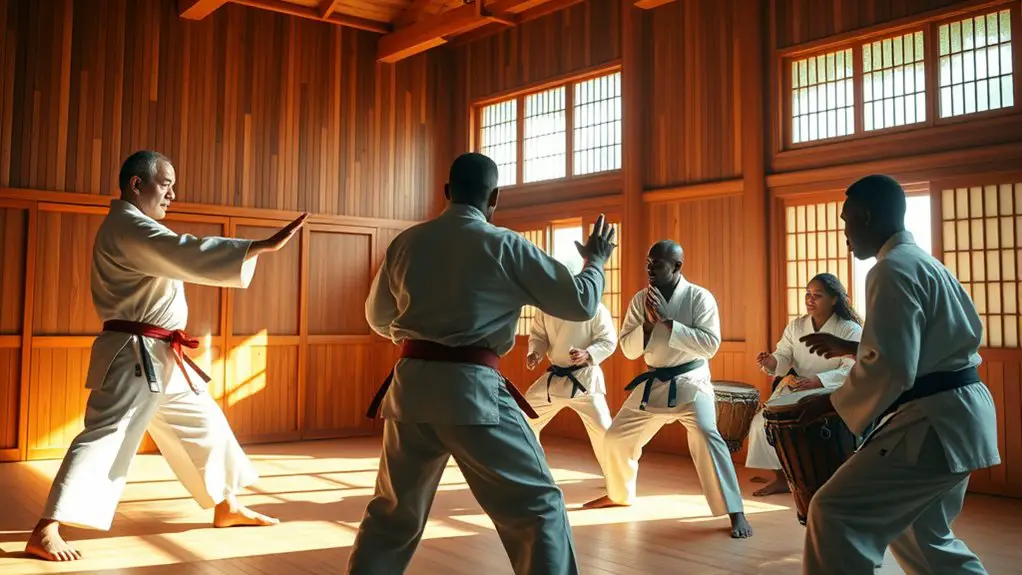
In the heart of Japan, the dojo serves as more than just a training space; it’s a sacred environment where tradition meets discipline. As you step onto the mat, you enter a domain where kata practice and sparring techniques intertwine, shaping both body and mind. Kata practice, the choreographed forms, allows you to internalize movements, fostering precision and fluidity. Each stance, each strike is a lesson in focus and respect, connecting you to centuries of martial arts heritage.
In contrast, sparring techniques bring the practice to life, pushing your limits and enhancing your adaptability. Here, you learn to anticipate your opponent’s moves, cultivating a keen sense of awareness. The dojo becomes a crucible of growth, where rigorous training hones your physical prowess while instilling values like humility and perseverance. Through this blend of kata and sparring, you’re not just training; you’re initiating a transformative journey that transcends the physical domain.
Indigenous Knowledge Sharing: Learning in African Tribes
In African tribes, knowledge sharing thrives through rich oral traditions, where stories and teachings are passed down generations. You’ll see how community-based learning fosters a sense of belonging, allowing members to grow together, while mentorship and apprenticeship create strong bonds between the experienced and the novice. This holistic approach not only preserves cultural heritage but also equips individuals with practical skills essential for their community’s survival.
Oral Tradition Practices
While many cultures rely on written texts for knowledge transmission, African tribes have long embraced oral tradition practices that serve as essential conduits for sharing indigenous knowledge. These practices are rich in storytelling techniques, enabling communities to pass down ancestral wisdom through generations. You’ll find that oral traditions aren’t just about recounting tales; they’re interactive, engaging, and deeply contextual.
Key elements of these oral traditions include:
- Storytelling: Enchanting narratives that convey morals and lessons.
- Songs and Chants: Rhythmic expressions that enhance memory and cultural identity.
- Proverbs: Concise sayings that encapsulate complex ideas.
- Rituals: Ceremonial practices that reinforce shared histories.
- Community Participation: Involving listeners in storytelling to foster connection.
This dynamic exchange of knowledge enriches cultural understanding and community bonds.
Community-Based Learning
Building on the rich tapestry of oral traditions, community-based learning in African tribes emphasizes the importance of collective wisdom and shared experiences. You’ll find that this method thrives on collaborative projects where community members come together to tackle challenges, blending their unique skills and knowledge. Through these interactions, individuals learn not just from their elders, but also from their peers. Peer feedback plays a significant role, as it fosters an environment of mutual respect and growth. You’ll notice that this process isn’t just about acquiring knowledge; it’s about building relationships and understanding cultural values. As you engage in community-based learning, you’ll appreciate how it nurtures both personal development and the preservation of ancestral wisdom, creating a harmonious balance between tradition and innovation.
Mentorship and Apprenticeship
Mentorship and apprenticeship in African tribes serve as essential conduits for passing down indigenous knowledge, ensuring that skills and cultural practices are preserved across generations. Through various apprenticeship models, elders guide youth, fostering a deep understanding of their heritage. This cultural mentorship creates a strong bond between mentor and apprentice, enriching both parties.
Key aspects of this process include:
- Hands-on learning: Practical experience solidifies knowledge.
- Storytelling: Oral traditions teach values and history.
- Community involvement: Collective participation enhances social cohesion.
- Skill diversification: Apprentices learn multiple trades, adapting to community needs.
- Spiritual connection: Training often intertwines with cultural rituals, deepening respect for traditions.
These methods not only sustain knowledge but also empower individuals within their communities.
The Socratic Method: Greek Philosophical Dialogues
The Socratic Method invites you to engage in a dynamic dialogue that sharpens your critical thinking skills. Through a series of probing questions, it encourages a deeper understanding of complex ideas, pushing you to examine your beliefs and assumptions. This approach not only fosters intellectual growth but also cultivates a collaborative learning environment where insights emerge from discussion.
Engaging Critical Thinking Skills
How can we deepen our understanding of complex ideas through dialogue? Engaging in the Socratic Method fosters critical thinking by inviting you to explore concepts through questioning. This technique encourages you to analyze and reflect, enhancing your problem-solving skills. Here are key benefits of this method:
- Promotes critical analysis of assumptions
- Encourages exploration of diverse perspectives
- Develops articulation of your thoughts
- Fosters collaborative learning through dialogue
- Enhances the ability to reason logically
Dialogue-Based Learning Approach
While exploring the depths of philosophical inquiry, the Socratic Method stands out as a powerful dialogue-based learning approach that encourages participants to engage critically with ideas. This method fosters rich dialogue dynamics, allowing you to question assumptions and explore concepts in depth. By emphasizing open-ended questions and active participation, you create an environment where diverse cultural perspectives can emerge. Engaging in this form of dialogue not only sharpens your critical thinking skills but also cultivates empathy as you consider viewpoints different from your own. As you navigate these discussions, you’ll discover the transformative power of collaborative inquiry, enabling meaningful exchanges that challenge and expand your understanding of complex issues. Embrace this method to reveal new dimensions of learning.
Questioning for Deeper Understanding
Isn’t it fascinating how questioning can reveal deeper layers of understanding? The Socratic Method, rooted in Greek philosophy, emphasizes this through dialogue. By engaging in reflective questioning, you can challenge assumptions and spark insightful discussions. Here are a few benefits of this approach:
- Promotes critical thinking: Encourages deeper analysis of ideas.
- Enhances active listening: Fosters attentiveness to others’ perspectives.
- Builds communication skills: Develops the ability to articulate thoughts clearly.
- Encourages collaboration: Creates a shared learning environment.
- Stimulates curiosity: Inspires a desire to explore new concepts.
Nordic Coaching: Emphasizing Teamwork and Community
In Nordic coaching, where the principles of teamwork and community take center stage, athletes are often encouraged to view their training as a collective journey rather than a solitary pursuit. This method fosters strong team dynamics, allowing individuals to learn from each other through cooperative learning. You’ll notice that practices often include group drills, where the emphasis is on collaboration rather than competition.
Athletes are guided to support one another, which cultivates a sense of belonging and shared responsibility. This approach not only enhances performance but also builds resilience, as athletes learn to navigate challenges together. Coaches play a pivotal role, facilitating discussions that promote mutual respect and understanding. By prioritizing community, Nordic coaching creates an environment where everyone thrives, ultimately leading to a more cohesive team. When you embrace this philosophy, training transforms into a powerful experience that extends beyond individual achievement.
The Mindfulness Approach: Buddhist Techniques for Focus
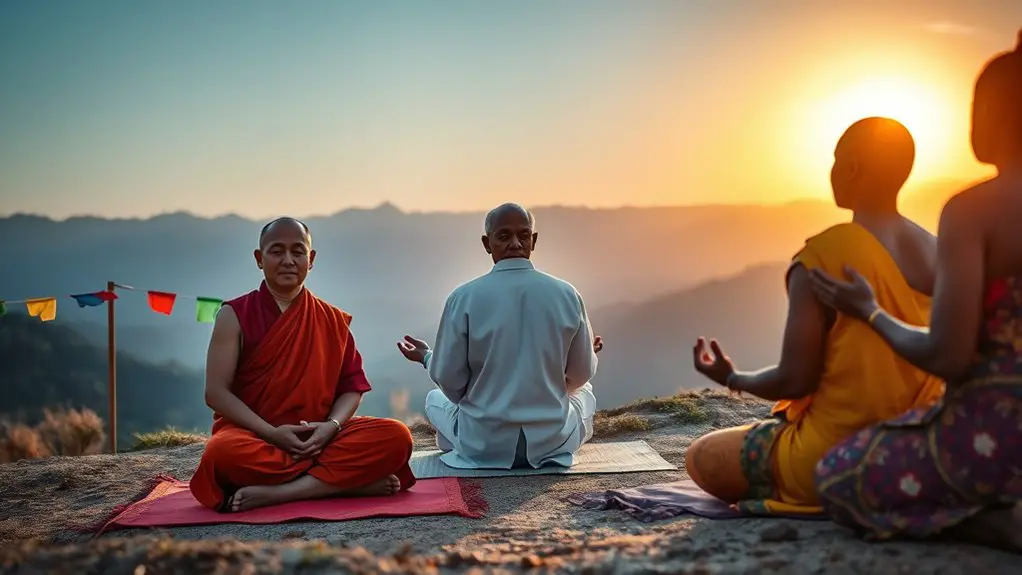
As you explore the mindfulness approach rooted in Buddhist techniques, you’ll discover a transformative method for enhancing focus and mental clarity. Central to this practice are mindful breathing and focused meditation, which help you cultivate awareness and presence in the moment. These techniques can greatly improve your concentration and reduce distractions, allowing you to perform at your best.
Consider these key aspects of the mindfulness approach:
- Mindful Breathing: Focus on your breath to anchor your thoughts.
- Focused Meditation: Set aside time to practice concentration on a single object or thought.
- Awareness of Thoughts: Acknowledge distractions without judgment, gently returning to your breath.
- Body Scan: Develop awareness of physical sensations to ground yourself.
- Consistency: Make mindfulness a daily ritual for sustained benefits.
Brazilian Jiu-Jitsu: The Importance of Adaptation and Flow
While you may initially think of Brazilian Jiu-Jitsu (BJJ) as just a physical combat sport, its true essence lies in the principles of adaptation and flow. In BJJ, you quickly learn that your success hinges on your ability to apply adaptation techniques to counter your opponent’s moves. This fluidity transforms the mat into a dynamic chessboard, where each position invites you to rethink your strategy.
Flow principles are equally significant; they teach you to maintain a continuous movement, allowing you to shift seamlessly between techniques. When you embrace this mindset, you become less rigid, more responsive, and ultimately more effective.
As you train, you’ll discover that it’s not just about strength or technique but about understanding how to read your opponent and adjust in real-time. This synergy of adaptation and flow fosters a deeper connection with the art, enhancing both your skills and enjoyment of BJJ.
The Gurukula System: Ancient Indian Methods of Education
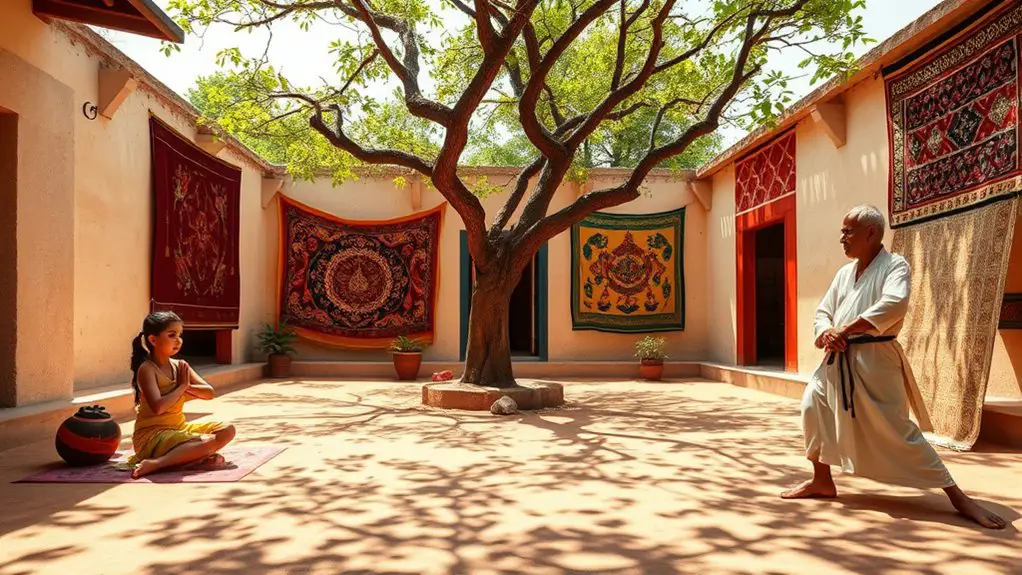
Though often overshadowed by modern educational systems, the Gurukula system represents a profound and holistic approach to learning that has shaped Indian culture for centuries. Rooted in the Gurukula philosophy, this ancient method emphasizes personalized education in a communal environment, fostering deep connections between teacher and student.
Key principles of the Gurukula system include:
- Mentorship: Teachers guide students in a nurturing manner.
- Holistic Learning: Education encompasses physical, mental, and spiritual growth.
- Immersive Experience: Learning occurs within a lived context, often in nature.
- Ancient Texts: Students engage with foundational texts, enriching their understanding.
- Community Involvement: Education is a shared responsibility, involving families and local culture.
Through these elements, the Gurukula system not only imparts knowledge but also cultivates character and ethical values, offering a timeless model for education that resonates even today.
The Maori Way: Cultural Identity and Community Learning
The Maori way of education intertwines cultural identity with community learning, creating a rich tapestry that shapes both individual and communal growth. In this approach, knowledge isn’t just transferred; it’s woven into the fabric of daily life, fostering cultural preservation and community resilience. Through storytelling, arts, and communal activities, learners connect deeply with their heritage, reinforcing a sense of belonging.
| Element | Description |
|---|---|
| Cultural Practices | Engaging in traditional arts, songs, and dances that reflect identity. |
| Community Involvement | Collaborative projects that strengthen ties among members. |
| Learning Methods | Experiential learning through hands-on activities and mentorship. |
| Impact | Builds pride in heritage while promoting social cohesion. |
The Russian System: Emphasizing Physical Conditioning and Technique
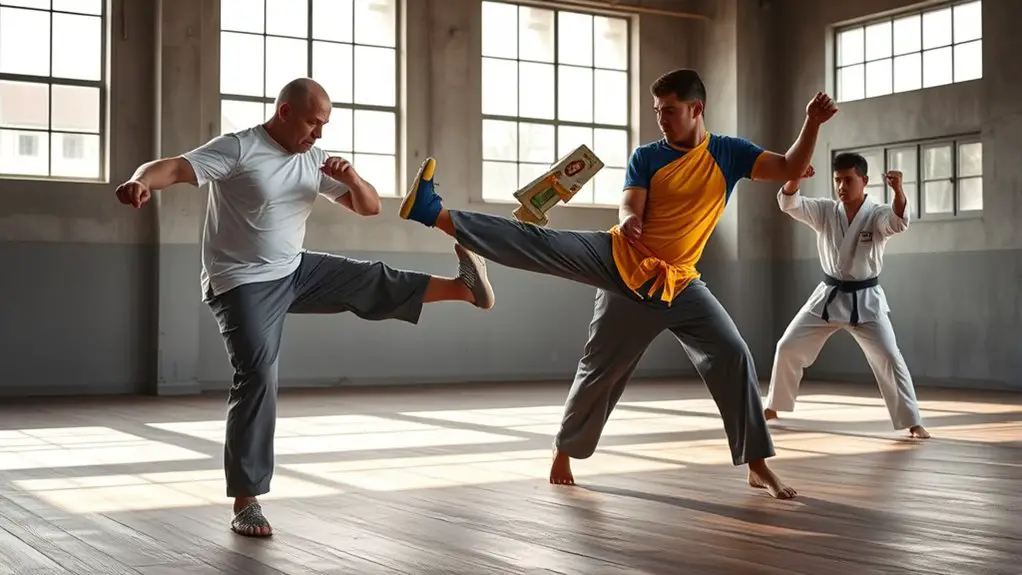
Incorporating a rigorous emphasis on physical conditioning and technique, the Russian training system has long been revered for its structured approach to developing athletes. This method prioritizes not just the physical aspects, but also the mental resilience required for peak performance.
Key components of this system include:
- Russian conditioning to build a robust foundation.
- Technique mastery through repetitive practice and focus.
- Strength endurance training to enhance performance under fatigue.
- Combat readiness to prepare for real-world challenges.
- Tactical drills that simulate competitive situations.
The Chinese Philosophy of Wu Wei: Effortless Action in Training
Harmony in movement defines the Chinese philosophy of Wu Wei, which emphasizes the concept of effortless action in training. By embracing the wu wei principles, you learn to align your body and mind, allowing movements to flow naturally. This approach fosters a state of relaxed concentration, making training feel less like a struggle and more like a dance.
You’ll find that adopting this mindset leads to effortless mastery; rather than forcing techniques, you cultivate sensitivity to your body’s signals and the environment around you. This fluidity not only enhances physical performance but also encourages mental clarity and resilience.
Incorporating Wu Wei into your training means embracing patience and trust in your journey. You’ll discover that progress comes more easily when you let go of rigid expectations and allow your instincts to guide you. Ultimately, this philosophy invites you to train with grace, effectively harmonizing effort with ease.
Frequently Asked Questions
How Can I Apply These Training Methods in Everyday Life?
To apply various training methods in your everyday life, start by integrating daily practices that resonate with you. You can blend techniques from different cultures, like mindfulness from Eastern traditions or teamwork from Western approaches. Experiment with these methods, reflecting on what enhances your productivity or well-being. By embracing cultural integration in your routines, you’ll cultivate a richer, more diverse personal development path that aligns with your unique lifestyle and goals.
Are There Any Specific Age Requirements for These Training Methods?
Age isn’t always a barrier; it’s about adaptability and awareness. When you explore various training methods, you’ll find age flexibility is often a key factor. Many cultures emphasize inclusivity, allowing people of different ages to participate. However, there are cultural considerations to keep in mind, as some practices may be more suitable for specific age groups. Always assess the needs and capabilities of individuals to create a meaningful training experience.
What Are the Costs Associated With These Training Programs Worldwide?
When exploring the costs associated with various training programs worldwide, you’ll find that cost breakdowns can vary considerably. Factors like location, duration, and content influence pricing. Some programs are funded through government grants or private sponsorships, while others may require personal investment. It’s essential to analyze these funding sources, as they can affect accessibility and overall affordability, ensuring you choose a program that aligns with both your budget and training goals.
Can These Methods Be Adapted for Virtual or Online Learning?
Absolutely, these methods can be adapted for virtual or online learning. By focusing on cultural adaptation, you can tailor content to resonate with diverse audiences. Incorporating interactive elements fosters online engagement, making learning more dynamic and effective. Utilizing multimedia tools, like videos and quizzes, can enhance retention and understanding. You’ll find that when methods reflect cultural nuances, they not only engage learners better but also create a more inclusive and enriching online experience.
How Do I Find Qualified Instructors for These Training Techniques?
Finding qualified instructors for your training techniques can be a challenge, especially given cultural differences that affect teaching styles. Start by researching instructors’ qualifications, looking for those with proven expertise in the specific techniques you’re interested in. Online platforms like LinkedIn or specialized training forums can help you identify potential candidates. Don’t hesitate to ask for references or even trial sessions to guarantee their teaching style aligns with your expectations and objectives.





